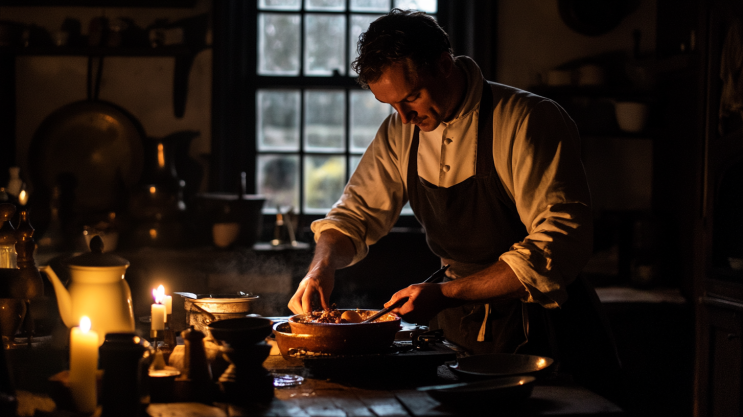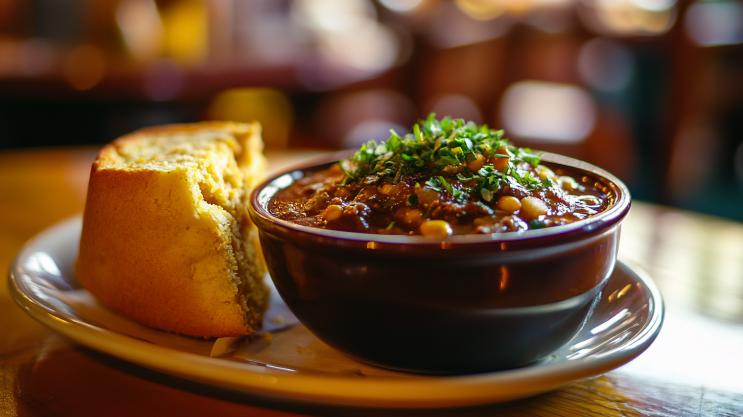
Table of Contents
Mock turtle soup is a fascinating dish with deep historical roots, blending the flavors of traditional turtle soup with an ingenious, budget-friendly twist. Originating in 18th-century England, this dish was created as an alternative to real turtle soup, which had become a prized and expensive delicacy. Using calf’s head, offal, and rich seasonings, early cooks crafted a hearty, flavorful soup that mimicked the texture and taste of the original. Today, mock turtle soup continues to be enjoyed in various regions, especially in parts of England and the United States.
This article explores the history, ingredients, preparation methods, cultural impact, and modern adaptations of mock turtle soup. We’ll delve into its origins, discuss key ingredients and substitutions, and highlight its presence in literature and popular culture. Finally, we’ll answer some frequently asked questions about this dish, including its availability and legal status.
The Origins and History of Mock Turtle Soup

History of Turtle Soup and the Emergence of Imitation Dishes
Before the invention of mock turtle soup, real turtle soup was a highly sought-after delicacy in Europe and North America. During the 18th and 19th centuries, green sea turtles were imported in large quantities to meet the growing demand for this luxurious dish. The soup was a staple at banquets, royal feasts, and high-society gatherings, signifying wealth and sophistication.
However, as overfishing led to a decline in turtle populations, prices soared, making it nearly impossible for the average household to afford real turtle soup. This scarcity prompted cooks to develop a creative substitute—mock turtle soup, made from calf’s head, feet, and other gelatin-rich ingredients to replicate the soup’s signature texture and depth of flavor.
From Real Turtle Soup to Mock Turtle Soup: A Culinary Evolution
The transition from turtle soup to mock turtle soup was driven by necessity but also embraced for its unique taste and affordability. The use of calf’s head and offal provided the gelatinous consistency reminiscent of turtle meat, while rich seasonings like sherry, nutmeg, lemon, and herbs enhanced the dish’s flavor.
By the 19th century, mock turtle soup had become a staple in English households and even found its way into literature. Lewis Carroll’s Alice’s Adventures in Wonderland features a whimsical character known as the Mock Turtle, humorously referencing the dish’s name. Meanwhile, in the United States, cities like Cincinnati developed their own versions, incorporating ground beef and hard-boiled eggs to create a hearty, regional variation.
Even though real turtle soup faded from popularity due to conservation efforts, mock turtle soup endured as a nostalgic comfort food. Today, it remains a cherished dish in British cuisine, a regional specialty in the Midwestern U.S., and a historic recipe that continues to be passed down through generations.
Traditional Ingredients and Modern Variations
Key Ingredients and Their Culinary Roles in Mock Turtle Soup
Mock turtle soup was originally devised as a cost-effective alternative to the luxurious turtle soup, utilizing accessible ingredients to replicate the rich flavors and textures of the original. The primary component was often a calf’s head, chosen for its gelatinous qualities that mimic the consistency of turtle meat. This choice provided a hearty base, essential for achieving the desired mouthfeel.
In addition to the calf’s head, early recipes incorporated organ meats and offal, such as brains and feet, to enhance the depth of flavor. These elements contributed to a robust and savory profile, essential for an authentic mock turtle soup. Aromatic vegetables like onions, celery, and carrots were sautéed to form a flavorful foundation, while herbs and spices—including thyme, bay leaves, and mace—added complexity to the broth.
To enrich the soup further, cooks often added wine or sherry, imparting a subtle sweetness and acidity that balanced the savory components. The inclusion of hard-boiled eggs, either chopped or as whole yolks, was a distinctive feature, offering a contrasting texture and visual appeal. Lemon peel or juice was sometimes introduced to provide a bright, citrusy note, cutting through the richness of the dish.
Regional Variations and Contemporary Substitutions
As mock turtle soup traversed different regions and eras, adaptations emerged to suit local tastes and ingredient availability. In the United States, particularly in Cincinnati, the soup evolved to feature ground beef or stew meat as a substitute for calf’s head, reflecting both practicality and changing palates. This version often includes tomatoes, creating a reddish hue and a slightly tangy flavor profile distinct from its English counterpart.
Modern interpretations of mock turtle soup have adapted to contemporary preferences and ingredient accessibility. Given the rarity and ethical considerations surrounding the use of calf’s head and organ meats today, many recipes opt for more conventional cuts of beef, such as oxtail or beef shank, which still provide the desired richness and gelatinous texture. Some versions incorporate mushrooms to introduce an earthy depth, catering to vegetarian inclinations while maintaining the soup’s hearty character.
Incorporating seafood, such as clams or oysters, is another modern twist, paying homage to the dish’s maritime origins while appealing to contemporary palates. The use of pressure cookers or slow cookers has also streamlined the preparation process, making it more accessible to home cooks without compromising the soup’s traditional depth of flavor.
These adaptations demonstrate the versatility of mock turtle soup, showcasing how a classic dish can evolve while preserving its core identity. Whether adhering to traditional methods or embracing modern variations, the essence of mock turtle soup remains a celebration of resourcefulness and culinary heritage.
Cooking Techniques and Recipe Development
Classic Preparation Methods for Authentic Mock Turtle Soup
Preparing traditional mock turtle soup is a meticulous process that reflects its historical roots. The journey begins with selecting the primary protein; historically, this was a calf’s head, chosen for its ability to impart a rich, gelatinous quality to the broth. The head would be thoroughly cleaned, scalded to remove hair, and then simmered slowly to extract maximum flavor and achieve a tender texture.
Once the meat was cooked, it would be carefully removed, and the broth strained to ensure clarity. The meat, including delicate parts like the brains, was then diced into uniform pieces and returned to the pot. A roux made from butter and flour was prepared separately to thicken the soup, providing a luxurious mouthfeel. Aromatic vegetables—such as onions, celery, and carrots—were sautéed and added to the mix, infusing the broth with layered flavors.
Seasonings played a pivotal role in achieving the distinctive taste of mock turtle soup. Traditional recipes called for a blend of herbs and spices, including thyme, bay leaves, mace, and a hint of cayenne pepper for subtle heat. The addition of wine or sherry introduced a nuanced sweetness and depth, elevating the overall flavor profile. Hard-boiled eggs, either chopped or added as whole yolks, were incorporated towards the end of the cooking process, offering a unique texture and enriching the soup’s visual appeal.
The culmination of these steps resulted in a hearty, flavorful soup that mirrored the esteemed turtle soup, showcasing culinary ingenuity in the face of scarcity.
Innovative Twists and Modern Recipe Adaptations
In contemporary kitchens, mock turtle soup has undergone transformations that honor its origins while embracing modern tastes and conveniences. Given the decline in availability and the ethical considerations of using calf’s head, cooks have turned to alternative ingredients that replicate the desired texture and flavor.
Cuts like oxtail, beef shank, or even brisket have become popular substitutes, providing the necessary richness and gelatinous quality. These meats are simmered slowly to extract deep flavors, much like the traditional method. For those seeking a quicker preparation, pressure cookers or slow cookers have become invaluable tools, reducing cooking time while still achieving a tender, flavorful result.
Flavor enhancements have also evolved. While sherry remains a favored addition, some recipes experiment with port or Madeira wines, introducing different notes of sweetness and complexity. The inclusion of tomatoes, particularly in American adaptations, adds acidity and a vibrant color, creating a variation that has become a regional favorite.
For a modern twist, some chefs incorporate seafood elements, such as clams or oysters, paying homage to the soup’s maritime connections. Vegetarian versions have also emerged, utilizing mushrooms and broths to mimic the hearty depth of the original, catering to diverse dietary preferences.
Cultural Impact and Pop Culture References
Mock Turtle Soup in Literature and Media
Mock turtle soup has not only been a culinary staple but has also found its way into various cultural and literary works. One of the most notable references appears in Lewis Carroll’s 1865 classic, Alice’s Adventures in Wonderland. In this whimsical tale, Alice encounters the Mock Turtle, a character who is a satirical portrayal of the dish itself. The Mock Turtle laments about his existence, humorously reflecting the concept of a “mock” or imitation turtle used in the soup. This clever wordplay highlights the dish’s prominence in Victorian England and showcases Carroll’s knack for infusing contemporary cultural elements into his storytelling.
Beyond literature, mock turtle soup has made appearances in various media forms, symbolizing tradition and nostalgia. Its inclusion in period dramas and historical narratives often serves to evoke a sense of authenticity and immersion into the era depicted. The dish’s rich history and unique preparation have made it a subject of interest in culinary documentaries and food history programs, further cementing its place in cultural discourse.
Local Traditions and the Soup’s Enduring Appeal
In certain regions, particularly in the United States, mock turtle soup has become more than just a dish; it’s a cherished tradition. Cincinnati, Ohio, stands out as a city where the soup has been embraced wholeheartedly. The local version typically features ground beef and hard-boiled eggs, diverging from the original calf’s head recipe. This adaptation has been so well-received that mock turtle soup is a common offering at family gatherings, community events, and even on restaurant menus throughout the city. The enduring popularity in Cincinnati showcases how regional adaptations can breathe new life into traditional dishes, allowing them to remain relevant and beloved across generations.
The soup’s appeal also lies in its rich, hearty nature, making it a comforting meal during colder months. Its complex flavors and historical roots provide a sense of connection to the past, allowing individuals to partake in a culinary experience that has been enjoyed for centuries. Whether prepared according to traditional recipes or modern interpretations, mock turtle soup continues to be a testament to culinary ingenuity and cultural resilience.
Frequently Asked Questions (FAQs)
What is mock turtle soup made of?
Mock turtle soup is a traditional English dish created as a cost-effective substitute for green turtle soup. Originally, it was made using a calf’s head to replicate the texture and richness of turtle meat. The recipe often included organ meats, aromatic vegetables like onions, celery, and carrots, and was seasoned with herbs such as thyme and bay leaves. A splash of sherry or wine was commonly added for depth of flavor. In modern adaptations, more accessible cuts of meat like beef shank or oxtail are used, and some variations incorporate ground beef, especially in American versions. Hard-boiled eggs are also a distinctive addition in many recipes.
What does mock turtle soup taste like?
The flavor of mock turtle soup is rich and savory, with a hearty, meaty base complemented by the sweetness of cooked vegetables and the subtle warmth of spices. The addition of sherry or wine imparts a slight acidity and complexity, balancing the robust flavors. The texture is often thick and stew-like, with tender pieces of meat and the occasional bite of hard-boiled egg adding to its unique mouthfeel. Overall, it’s a comforting dish with deep, layered flavors that have stood the test of time.
Can you still get mock turtle soup?
Yes, mock turtle soup is still available today, though its prevalence varies by region. In Cincinnati, Ohio, for instance, the soup remains a local specialty and can be found in certain restaurants and markets. Some specialty food stores and online retailers offer canned versions of the soup. Additionally, numerous recipes are available for home cooks interested in preparing the dish themselves, allowing them to experience this historic culinary creation firsthand.
Is turtle soup illegal in the US?
The legality of turtle soup in the United States depends on the species of turtle used and state-specific wildlife conservation laws. Many turtle species are protected due to declining populations and environmental concerns, making it illegal to hunt, sell, or consume them. As a result, traditional turtle soup made from these species is generally prohibited. However, mock turtle soup, which uses alternative meats like beef to replicate the flavor and texture of turtle meat, is entirely legal and serves as a popular substitute that honors the original dish’s essence without impacting wildlife populations.
Modern-Day Popularity and Regional Variations

Mock Turtle Soup in the United States
While mock turtle soup may not be as common as it once was, certain regions, particularly Cincinnati, Ohio, have kept the tradition alive. In Cincinnati, the dish has evolved into a local specialty, often featuring ground beef instead of calf’s head, along with tomatoes, eggs, and spices for added depth. Many restaurants and delis in the area still serve this nostalgic dish, and families pass down their unique recipes through generations.
Beyond Cincinnati, some Southern states also feature mock turtle soup in their culinary repertoire. These versions tend to be richer, often including a roux-based thickener, Worcestershire sauce, and a splash of bourbon or sherry for enhanced flavor.
Mock Turtle Soup in the UK and Europe
In England, mock turtle soup remains a part of traditional British cuisine, though it is now mostly prepared for historical reenactments or special events. Some chefs have revived the dish with modern twists, replacing organ meats with slow-cooked beef or veal to suit contemporary palates.
Germany also has its own take on mock turtle soup, known as Mockturtlesuppe. This version is similar to the British recipe but may include additional herbs and spices unique to German cooking traditions. It remains a comfort dish, especially in northern Germany, where it is served during colder months.
How to Make Your Own Mock Turtle Soup

Ingredients You’ll Need
Making mock turtle soup at home is a rewarding experience, allowing you to explore the dish’s rich history while customizing it to your taste. Here’s a basic ingredient list:
- 2 lbs of beef shank or ground beef (or traditional calf’s head if preferred)
- 1 large onion, diced
- 2 carrots, diced
- 2 celery stalks, diced
- 3 cloves of garlic, minced
- 6 cups beef or veal broth
- 1 cup tomato puree
- 2 hard-boiled eggs, chopped
- 1/4 cup sherry or Madeira wine
- 1 tsp Worcestershire sauce
- 1 tsp thyme
- 1 bay leaf
- Salt and pepper to taste
- Butter and flour for thickening (optional)
Step-by-Step Cooking Instructions
- Prepare the Meat – If using beef shank or calf’s head, simmer the meat in broth for 2-3 hours until tender. If using ground beef, brown it in a large pot.
- Sauté the Vegetables – In a separate pan, melt butter and sauté onions, carrots, celery, and garlic until softened.
- Combine Ingredients – Add the vegetables, tomato puree, and seasonings to the pot with the meat and broth.
- Simmer the Soup – Let the mixture cook on low heat for at least an hour to allow flavors to meld.
- Add Final Touches – Stir in chopped hard-boiled eggs, Worcestershire sauce, and sherry. Adjust seasoning as needed.
- Serve and Enjoy – Garnish with fresh herbs and serve hot with crusty bread.
For a unique take, try adding a squeeze of lemon juice or a splash of vinegar for brightness, or experiment with different meats and seasonings to craft your perfect version of this historical dish.
The Cultural Significance of Mock Turtle Soup
Mock Turtle Soup in Literature and Art
Mock turtle soup gained cultural recognition through its inclusion in famous literature, most notably in Alice’s Adventures in Wonderland. The character of the Mock Turtle is a direct reference to the dish, adding a whimsical element to Lewis Carroll’s story.
Beyond literature, the dish has been mentioned in historical cookbooks and even appeared in paintings and menus from the Victorian era.
Mock Turtle Soup’s Role in Family Traditions
For many, mock turtle soup is more than just a meal—it’s a cherished family tradition. Recipes are passed down through generations, particularly in regions like Cincinnati, where it remains a nostalgic comfort food.
Where to Find and Enjoy Mock Turtle Soup Today
Restaurants That Serve Mock Turtle Soup
Although rare, some restaurants, particularly in Ohio and England, still serve authentic mock turtle soup as a nod to culinary history.
Making Mock Turtle Soup at Home
With its rich flavor and historical significance, making mock turtle soup at home is a great way to experience this classic dish. Follow our recipe above to create your own!

